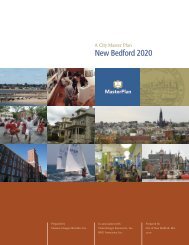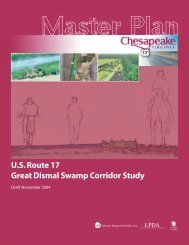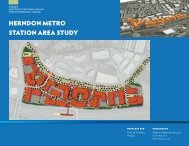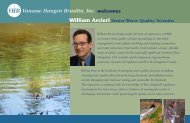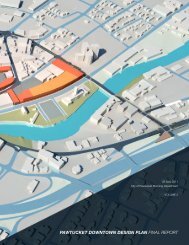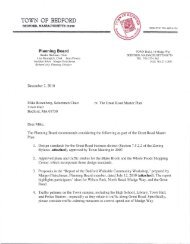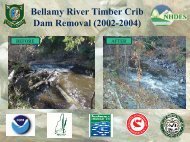Final Report - VHB.com
Final Report - VHB.com
Final Report - VHB.com
Create successful ePaper yourself
Turn your PDF publications into a flip-book with our unique Google optimized e-Paper software.
grasshopper sparrow (Ammodramus savannarum)<br />
S4 Rank (One Hit in the Study Area): Apparently secure in Maine:<br />
bald eagle (Haliaeetus leucocephalus)<br />
2.3.7 Wildlife Habitat<br />
Requests were made to Beginning with Habitat (BwH) and the Gulf of Maine Coastal<br />
Program to document areas of significant habitat in the Study Area. A response with<br />
a series of GIS data was received on April 28, 2009. The BwH program maintains<br />
sufficient habitat information to support all native plant and animal species currently<br />
breeding in Maine. The request resulted in the identification of several important<br />
habitat systems: Essential Fish Habitat (i.e., Atlantic salmon), Inland Waterfowl &<br />
Wading Bird Habitat, Upland Sandpiper and Grasshopper Sparrow Habitat, and a<br />
Focus Area of Ecological Significance (i.e., Kennebec Estuary). Transportation<br />
Strategies 1, 2A, and 2C and Rail Strategy 3 occur in these habitat areas, which are<br />
shown in Figure 2-11.<br />
2.3.8 Hazardous Materials<br />
Available databases of known environmental-hazard sites supplied by the Maine<br />
Department of Environmental Protection were reviewed. The review identified<br />
several known locations of remediation sites, hazardous-oil spill sites, registered<br />
petroleum tanks, threats to groundwater and environmental monitoring, and<br />
wastewater outfalls in the Study Area. Threats to groundwater and environmental<br />
monitoring locations include the following:<br />
industrial <strong>com</strong>plexes<br />
Resource Conservation and Recovery Act (RCRA) small- and medium-quantity<br />
generators<br />
underground injection sites<br />
registered petroleum tanks including underground storage tanks for No. 2 fuel<br />
oil, gasoline, and diesel<br />
hazardous-oil spill sites including gasoline, waste oil, motor oil, and diesel<br />
This review revealed numerous potential hazardous-material sites, reflecting the<br />
long history of <strong>com</strong>mercial and industrial sites in the area. In total, the Study Area<br />
was found to contain the following (Figure 2-12):<br />
9 remediation sites<br />
38 hazardous-oil spill sites<br />
30 registered petroleum tanks<br />
37 threats to groundwater and environmental monitoring<br />
Existing Conditions 51



